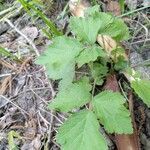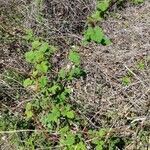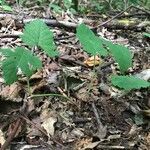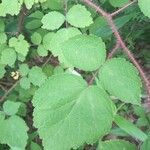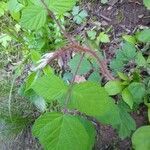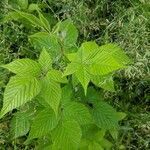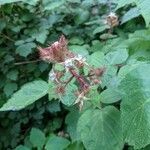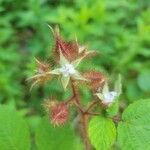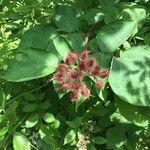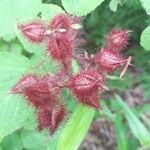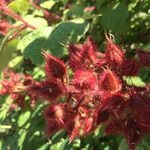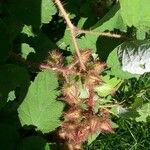Shrubs, 10–20(–30) dm, armed. Stems ?biennial?, arching, sparsely to moderately hairy, long-stipitate-glandular, not pruinose; prickles sparse to dense, erect to hooked, slender, 2–8(–10) mm, slender-based; ?bristles dense, 2–6 mm, usually gland-tipped and reddish purple, glands ellipsoid to narrowly cup-shaped?. Leaves deciduous, ternate; stipules filiform, 5–12 mm; terminal leaflets broadly deltate or ovate to suborbiculate, 4–15 × 3.5–14 cm, base truncate, rounded, or shallowly cordate, unlobed or dentate to shallowly, sharply or bluntly 3-lobed, margins coarsely serrate or doubly serrate, apex acute to acuminate, abaxial surfaces with scattered, erect to curved prickles on moderate-to large-sized veins, densely white-hairy, moderately to densely long-stipitate-glandular along veins. Inflorescences terminal and axillary, 5–30-flowered, cymiform to racemiform. Pedicels usually unarmed or prickles sparse, erect, moderately to densely hairy, densely long-stipitate-glandular. Flowers bisexual; petals white to pink, ovate to suborbiculate, 4–6 mm; filaments laminar; ovaries glabrous. Fruits red to maroon, globose, 1–1.5 cm; drupelets 15–40, strongly coherent, separating from torus. 2n = 14.
Robust, suckering, scrambling shrub; stems terete, erect near base, distally trailing, up to 4 m high, hairy and densely covered in reddish, glandular bristles; armature of sparse, slender, mostly straight, flattened prickles. Lvs pinnately 3-foliolate; leaflets rugose and slightly pilose to subglabrous on upper surface, white-tomentose on lower surface, unevenly 1-2-serrate and often lobed; terminal leaflet lamina broadly ovate to orbicular, (20)-70-130 × (20)-60-130 mm, acute to acuminate, rounded to cordate at base, with petiolule 1/4-1/2 length of lamina; stipules linear; uppermost lvs sometimes simple. Infl. a short, terminal panicle leafy at base; axis and branches pilose and with dense reddish, glandular bristles. Fls c. 15-35 mm diam. Sepals triangular-lanceolate, long-acuminate, hairy and densely glandular, enclosing the fls and young fr. Petals orbicular, flat, pale pink to red. Fr. of orange-red to dark red drupelets, broad-conic to subglobose, c. 10-15 mm long.
Stems arching, to 2 m, armed with a few slender prickles, densely shaggy with long (3–5 mm), purple, glandular hairs, as also the petioles and infl; lfls 3, densely white-tomentose beneath, the terminal one broadly ovate, abruptly short-acuminate, rounded at base, the lateral similar but much smaller; infl a many-fld cymose panicle; sep glandular-hairy; pet white, narrowly ovate, erect, much shorter than the sep; fr red, 1 cm thick, separating as a unit from the persistent receptacle; 2n=14. Native of e. Asia, well established as an escape from cult. in our range, especially along the Atlantic coast.
A shrub or climbing vine. It grows 1-3 m tall. It can spread 3 m wide. The branches are upright at first and scrambling later. They are densely hairy. They do not have thorns. The leaves have 3 leaflets and are broadly egg shaped. They have coarse teeth along the edge and are white and like felt underneath. The flowers are pink. The fruit are small round orange coloured berries. They are 1 cm across. The fruit are edible.
